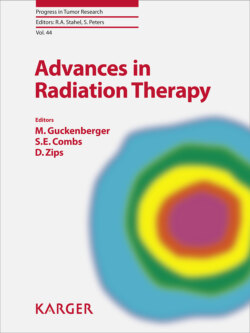Читать книгу Advances in Radiation Therapy - Группа авторов - Страница 44
На сайте Литреса книга снята с продажи.
PET-Based Proliferation Imaging
ОглавлениеOne way to measure proliferation, or the effect of proliferation, is to measure the anatomical size of a tumor. Besides the delay in the visibility of the size-effect, even after weeks, size does not provide information on the tissue viability and is therefore an impaired biomarker. This makes 18F-fluorothymidine (18F-FLT) PET imaging, which visualizes cell proliferation, an attractive alternative. As it is not (yet) routinely used in the clinical practice of radiotherapy, it is an often-used imaging biomarker in research. Dose escalation based on 18F-FLT PET has been suggested and was shown to be technically feasible [49].
Mechanism of 18F-FLT Uptake and Accumulation
18F-FLT is a radiolabeled variant of the nucleoside thymidine. After intravenous administration, 18F-FLT gets transported into the cell by nucleoside transporters. The enzyme thymidine kinase 1 (TK1) leads to monophosphorylation of 18F-FLT and thereby to trapping of 18F-FLT in the cell [9, 31]. During the S-phase of the cell cycle (DNA synthesis) TK1 is increased about 10-fold [49], which makes 18F-FLT visualize cell proliferation. This is confirmed by comparison of the 18F-FLT uptake with the cellular proliferation biomarker Ki-67. Ki-67 is exclusively present in the active phases of the cell cycle, and therefore strictly associated with cell proliferation [50]. 18F-FLT uptake and immunohistological analysis of Ki-67 expression showed a positive correlation [3], with the advantage of 18F-FLT being noninvasive and providing information of the entire imaged volume (whole body is possible), at the cost of a much lower resolution.
Imaging of 18F-FLT
18F-FLT PET provides reproducible quantitative imaging results [3, 14]. A decrease in uptake of 20–25% is greater than the reproducibility error [31] and can therefore be attributed to a decrease in proliferation. Imaging can be performed about 1 h after administration of the 18F-FLT, which is similar to the incubation period for imaging of 18F-FDG, the frequently used glucose analogue for PET imaging. Beyond 1 h of incubation, proliferation might be underestimated by leakage of the metabolite back into the blood [51].
Compared to FDG, FLT has a lower tumor uptake. For example, for contouring of the functional tumor volume, for FLT a threshold of 1.4 of the SUV results in a volume that is similar to the volume calculated with FDG with a 2.5 threshold [52]. When using imaging of proliferation for early response prediction, it should be considered that, although proliferation is a characteristic of the tumor, it is not exclusively a tumor cell characteristic. Not only do proliferating tumor cells accumulate 18F-FLT, but also, for example, proliferating B-lymphocytes in inflammatory lymph nodes [31] and in bone marrow [53]. Radiotherapy could increase uptake by inducing the proliferation of inflammatory cells in certain areas [31]. A relatively high background uptake in the liver and genitourinary system complicates the imaging of proliferation with 18F-FLT in these areas. This limits the specificity of this biomarker and makes 18F-FLT imaging better suited for the monitoring of treatment response than for staging [9, 14, 53].
For early response assessment, in head and neck cancer it was shown that already in the second week of treatment the decrease in 18F-FLT uptake is indicative of the treatment outcome [54]. This allows the treatment protocol to be changed, for example accelerated. Since the 18F-FLT uptake decreases at least during the first 4 weeks of therapy [31], the timing influences the outcome of the quantification.
The preparation of 18F-FLT is different from 18F-FDG. It requires, for example, a purification because of toxic side products. In contrast to the widely used FDG, in most institutes FLT is not easily available, which limits its use.
Perspective
Although 18F-FLT-PET proved to assess radiotherapy treatment response earlier than 18F-FDG-PET and CT tumor response [55], currently 18F-FLT-PET is only applied within clinical studies. Unfortunately, these studies are mostly single-center studies with a small sample size. Similar to studies applying 18F-FDG-PET, standardization of 18F-FLT-PET is required to enable the comparison and combination of clinical study results. Guidelines like the EANM guideline for 18F-FDG-PET should also become available for other tracers, such as 18F-FLT. This would stimulate harmonization and therefore increase the chance of success for these biomarkers.
